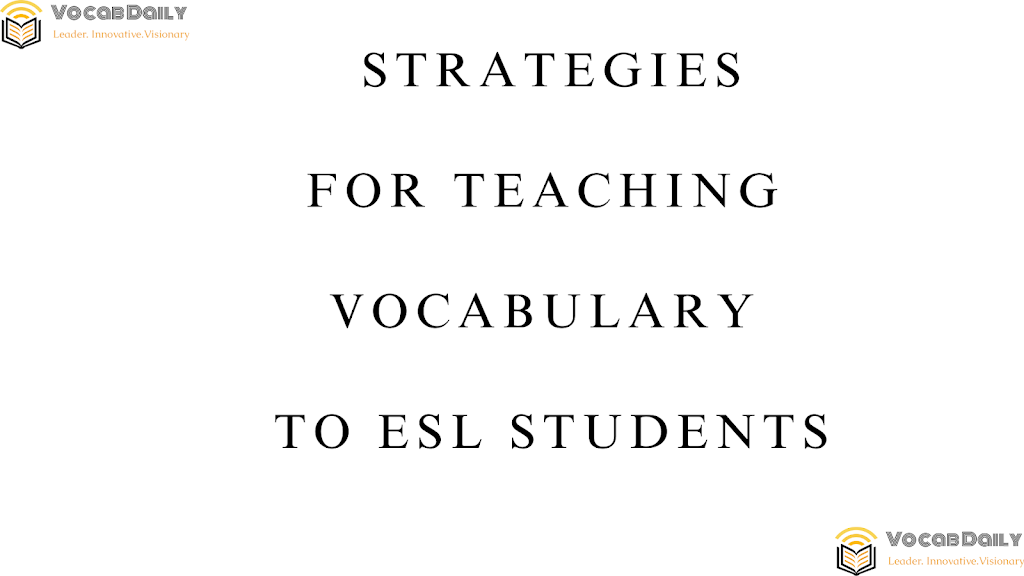Strategies for Teaching Vocabulary to ESL Students
Teaching vocabulary to English as a Second Language (ESL) students presents unique challenges and opportunities. Effective vocabulary instruction is crucial for ESL learners to develop language proficiency and succeed in academic and social contexts. This article explores various strategies to enhance vocabulary teaching for ESL students, focusing on methods that are engaging, culturally sensitive, and tailored to diverse learning needs.
Contextual Learning
One of the most effective strategies for teaching vocabulary to ESL students is through contextual learning. Instead of presenting words in isolation, introduce new vocabulary within meaningful contexts. This approach helps students understand not just the definition of a word, but also how it’s used in real-life situations.Use authentic materials such as newspaper articles, song lyrics, or short stories to provide context. For example, when teaching food-related vocabulary, you might use a recipe or a restaurant menu. This method allows students to see how words are used naturally and helps them remember the vocabulary more effectively.
Visual Aids and Realia
ESL students often benefit greatly from visual learning techniques. Incorporate pictures, diagrams, and real objects (realia) into your lessons to provide concrete representations of new words. This is particularly effective for concrete nouns and action verbs.Create vocabulary walls in your classroom with images and corresponding words. Use gestures and facial expressions to demonstrate the meanings of verbs and adjectives. For abstract concepts, try using mind maps or conceptual diagrams to show relationships between words and ideas.
Total Physical Response (TPR)
Total Physical Response is a language teaching method that coordinates language with physical movement. It’s particularly effective for teaching action verbs and spatial prepositions to ESL students. Give commands that students respond to physically, such as “Stand up,” “Turn around,” or “Point to the door.”Extend this method by having students create their own actions for new vocabulary words. This kinesthetic approach not only makes learning more engaging but also helps in better retention of new words.
Vocabulary Notebooks
Encourage ESL students to maintain personal vocabulary notebooks. These notebooks can be more than just lists of words and definitions. Students should include example sentences, synonyms, antonyms, and even drawings or personal associations with each word.Implement regular activities that involve using these notebooks, such as vocabulary sharing sessions where students present new words they’ve learned to the class. This practice promotes active engagement with new vocabulary and encourages independent learning.
Technology Integration
Leverage technology to enhance vocabulary learning for ESL students. There are numerous apps and online tools designed specifically for vocabulary acquisition. Tools like Quizlet, Duolingo, or Memrise offer interactive flashcards and games that make learning new words engaging and fun.Encourage students to use online dictionaries that provide pronunciations, example sentences, and even visual representations of words. Video platforms like YouTube can be excellent resources for providing context and visual support for new vocabulary.
Semantic Mapping
Semantic mapping is a visual strategy for vocabulary instruction that helps students see how words relate to one another. Create word webs or concept maps that show relationships between words in a particular topic or theme.For instance, when teaching weather-related vocabulary, create a map with “Weather” at the center, branching out to categories like “Temperature,” “Precipitation,” and “Wind,” and then further to specific vocabulary words. This method helps ESL students understand word relationships and improves their ability to use words in appropriate contexts.
Culturally Responsive Teaching
Be mindful of the diverse cultural backgrounds of your ESL students when teaching vocabulary. What might be a common word or concept in one culture could be unfamiliar in another. Use this diversity as an opportunity to enrich vocabulary learning.Encourage students to share words from their native languages and discuss how concepts might be expressed differently across cultures. This approach not only expands vocabulary but also promotes cultural awareness and inclusivity in the classroom.
Frequent Review and Recycling
Consistent review is crucial for vocabulary retention, especially for ESL learners. Implement regular review sessions using varied activities to keep students engaged. Use games, quizzes, or writing exercises that require students to use previously learned vocabulary in new contexts.Recycle vocabulary by intentionally using taught words in different lessons and contexts throughout the course. This spaced repetition helps reinforce learning and encourages active use of new vocabulary.
Peer Teaching and Collaborative Learning
Utilize peer teaching and collaborative learning strategies to enhance vocabulary acquisition. Pair students to teach each other new words or have small groups work together on vocabulary-based projects.Activities like “word expert” presentations, where each student becomes an expert on a specific word and teaches it to the class, can be highly effective. This approach not only reinforces learning but also builds confidence and speaking skills.
Personalization and Relevance
Make vocabulary learning personally relevant to ESL students. Encourage them to select words that are meaningful to their lives, interests, or academic goals. This personalized approach increases motivation and makes vocabulary learning more engaging and memorable.Create assignments that require students to use new vocabulary in contexts relevant to their experiences. For example, have them write about their hobbies using newly learned words or describe their cultural traditions using target vocabulary.By implementing these diverse strategies, educators can create a rich, engaging environment for vocabulary learning that caters to the unique needs of ESL students. Remember that consistency, variety, and relevance are key to successful vocabulary instruction.For more resources on teaching vocabulary to ESL students, visit www.https://vocabdailyofficial.blogspot.com/. Additionally, explore our comprehensive vocabulary workbook tailored for ESL learners at https://shorturl.at/0a0Qc.


Leave a Reply